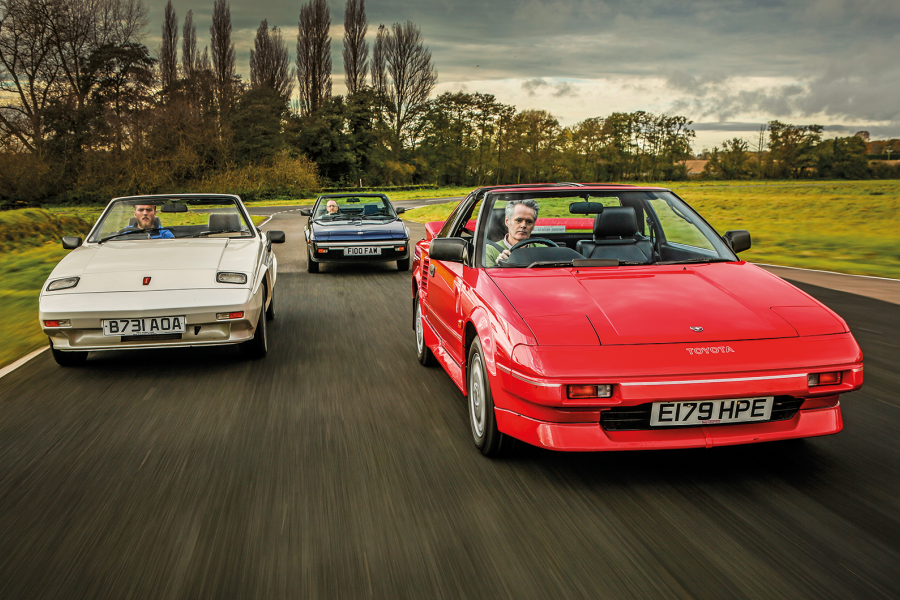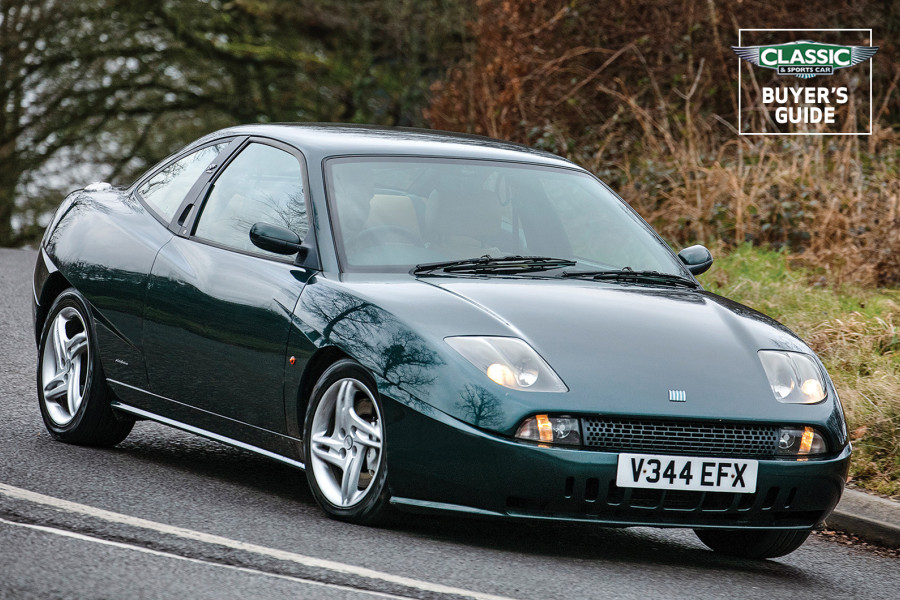You soon realise that this early car thrives on revs, so it’s fortunate that, other than a short phase of mid-range buzziness, the engine is generally smooth in its upper reaches, and a joy to work hard.
The Fiat X1/9’s roof-hoop artfully disguises a roll-over bar
It lacks torque, though, which isn’t helped by the sizeable gap between third and fourth gears. Despite that, top still only results in 16.6mph/1000rpm, meaning a dizzying 4200rpm at the national speed limit.
Dynamically, you really do wonder if car development has hit reverse in the past 50 years.
The X1/9’s unassisted steering is sublime: light, linear, quick to turn in, and with just the right level of feedback through its 165/70x13 tyres.
Front-end grip is tenacious, and it takes heroic attempts to even approach mild understeer in the dry.
The later 1500 switched to a quarterlight-mounted mirror
Body control over crests and slicing through well-sighted bends is impeccable: an MGB wouldn’t see which way it went.
Only when you really push hard do you start to feel the engine’s weight causing the body to roll over the rear axle, but it’s never less than composed.
So, did installing the 1500 engine turn the X1/9 into the car it should have been from start?
Receiving its world debut at the 1978 British motor show, the second-series X1/9 used the recently launched Strada’s engine, essentially the same unit as before but stroked to give 1498cc, and mated to a five-speed ’box.
The Fiat X1/9 1500’s bonnet features the crest of Bertone
While the chassis and most other mechanicals were unchanged, some of the X1/9’s original design purity was lost with the addition of Federal bumpers, adding a not insignificant 5½in (140mm) to its length.
The cabin was also given a full makeover, with a tidier layout, pushbuttons instead of rockers, and accoutrements such as electric windows and – on special-edition models such as ‘our’ car – leather trim.
Weight increased from 1940lb to 2028lb but, crucially, so did the engine’s overall power and torque to 85bhp and 87lb ft – up 16% and 20% versus the 1300.
The plush Versione Speciale adds niceties such as leather trim and electric windows
Once again, Motor tested the car and cut 2.3 secs from the 1300’s 0-60mph time and a staggering 15.3 secs from 0-90mph, with commensurate improvements in all the in-gear acceleration figures.
Sam Read’s 1984 1500 VS (Versione Speciale), purchased recently as a starter classic, is typical of the more generously specified X1/9s made before production halted in 1989.
Technically speaking, it’s not even a Fiat.
Flat-dish alloys on the Fiat X1/9 1500 retain the shape of the first-series car’s Cromodoras
Originally, Bertone only manufactured the base car at its Grugliasco plant near Turin, with Fiat looking after final assembly at its Lingotto factory.
But from 1981, the carrozzeria took on full production and rebadged the model as the Bertone X1/9, though it was still sold through Fiat’s dealer network.
Visually, swapping from 1300 to 1500 is like comparing two photographs of the same person taken a decade apart, their different clothes and barnets reflecting ever-changing fashions.
‘Visually, swapping from 1300 [right] to 1500 is like comparing two photographs of the same person, taken a decade apart’
Inside, some of the 1300’s quirky character has been lost, replaced by a more logical but slightly soulless layout, though beneath it the same key elements remain (main instruments, steering-wheel design, seating position).
But there’s no denying that this is a more driveable car, and one that would be easier to live with day to day.
The 1500 motor seems to possess a deeper timbre on start-up, and you immediately notice how much more quickly it responds to the throttle in the low-to-mid range, as you watch the rev counter’s needle sweep anti-clockwise around its dial (the 1300’s runs clockwise).
The Fiat X1/9 1300 (front) and 1500 are a pair of superbly rewarding drivers’ cars
At 70mph, the engine rotates at 400rpm less, and the higher ratios are more closely stacked, making it easier to stay on cam and exploit the biddable chassis.
The steering in this later model is perhaps a touch heavier, reflecting the car’s higher kerbweight, but this X1/9 is still everything you’d expect: poised, sharp and exciting.
Five decades on, there are few new cars that can genuinely claim to be all three.
Images: Max Edleston
Thanks to: Andy Rowley, X1/9 Owners’ Club; Reuben Elman at Lydden Hill Race Circuit
Baby Fiat’s all too brief stage show
Giorgio Pianta on the 1974 Tour de France; he would retire, but a sister Fiat X1/9 came home eighth overall © McKlein
In 1973, plans were drawn up to replace the Fiat-Abarth 124 Spider rally car, which resulted in the famed tuner developing two prototype successors in parallel: the 131 Abarth and the X1/9 Abarth.
Five X1/9 Abarth rally cars were built using either 16-valve, 1756cc 124 Abarth-derived units with twin Weber 44IDF carbs, or, in the case of one of the prototypes, a more extreme 1846cc ‘four’ with fuel injection, producing 210bhp.
Radically different in appearance to any regular production car, the X1/9 Abarths were identifiable by their flared arches, ducktail spoilers and prominent F1-style air intake mounted on the engine cover.
On only its third outing, in the 1974 Rally delle Alpi Orientali, the X1/9 Abarth was victorious, and it continued to enjoy considerable competition success through the season, despite some reliability issues.
However, even though the development team was on track to achieve homologation in Group 4 for 1975, Fiat instead opted to put its weight behind the new 131 Abarth rally car, and the X1/9 project was killed off.
Factfiles
Fiat X1/9 1300
- Sold/number built 1972-’79/c160,000 (all)
- Construction steel unitary
- Engine iron-block, alloy-head, ohc 1290cc ‘four’, with Weber 32DMTR twin-choke carburettor
- Max power 73bhp @ 6000rpm
- Max torque 71lb ft @ 3400rpm
- Transmission four-speed, manual, RWD
- Suspension independent, at front by MacPherson struts, lower lateral link, reaction strut rear MacPherson struts, lower wishbones
- Steering rack and pinion
- Brakes discs front and rear
- Length 12ft 6¾in (3830mm)
- Width 5ft 1¾in (1568mm)
- Height 3ft 10in (1168mm)
- Wheelbase 7ft 2½in (2197mm)
- Weight 1940lb (880kg)
- 0-60mph 12.3 secs
- Top speed 98mph
- Mpg 34
- Price new £2998 (1977)
- Price now £5-12,000*
Fiat X1/9 1500
- Sold/number built 1979-‘89/c160,000 (all)
- Construction steel unitary
- Engine iron-block, alloy-head, ohc 1498cc ‘four’, with Weber 34DATR7 twin-choke carburettor
- Max power 85bhp @ 6000rpm
- Max torque 87lb ft @ 3200rpm
- Transmission five-speed, manual, RWD
- Suspension independent, at front by MacPherson struts, lower lateral link, reaction strut rear MacPherson struts, lower wishbones
- Steering rack and pinion
- Brakes discs front and rear
- Length 13ft 2½in (3969mm)
- Width 5ft 1¾in (1568mm)
- Height 3ft 10in (1168mm)
- Wheelbase 7ft 2½in (2197mm)
- Weight 2028lb (920kg)
- 0-60mph 9.9 secs
- Top speed 108mph
- Mpg 37
- Price new £4575 (1979)
- Price now £4-10,000*
*Prices correct at date of original publication
READ MORE
Soul sisters: Fiat X1/9 vs Lancia Beta Monte-Carlo
Triumph Spitfire vs MGB vs Lotus Elan: a new dawn
Your classic: Triumph Spitfire 1500
Simon Hucknall
Simon Hucknall is a senior contributor to Classic & Sports Car






























